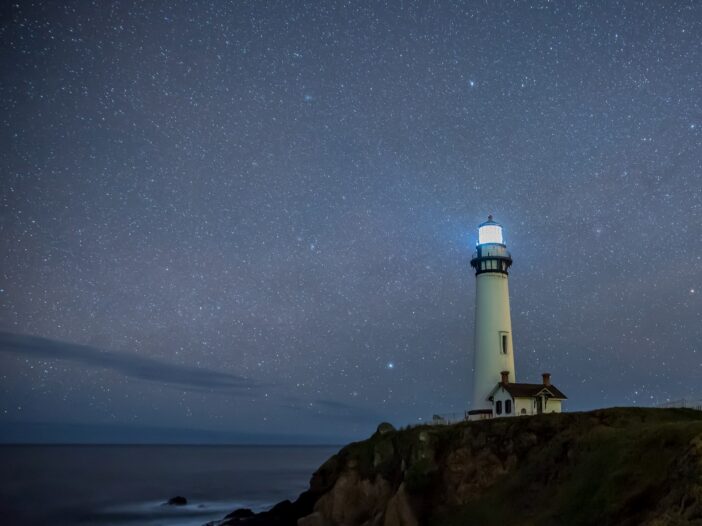
John Krasinski’s program Some Good News was a light in the darkness of 2020. Between March and May, it garnered more than 72 million views and 2.5 million YouTube subscribers. People flocked to it like moths to a flame.
Last year’s darkness reminded me how God is light without any darkness (1 John 1:5).
What does that mean? It contrasts God with moral and spiritual darkness, but more lies within those words. What does light tell us about God’s character? Our relationship with Him? And does science confound or confirm what the Bible says about light?
That’s a tall, two-fold order—because God exists as light and God created light. Science has more to say about the latter, so let’s start with that.
God controls and contains darkness.
God’s first creative acts on earth were to create light and separate it from darkness (Genesis 1:3-4). Did He push darkness to one side or set boundaries for it?
A physics article, “The Dark Side of Light,” supports the latter. “Natural light fields are threaded by lines of darkness, which … appear as black points within the light [emphasis mine].” The darkness possesses properties of a fractal—a repetitive mathematical pattern. (Fractals in nature include spirals in a nautilus shell, snowflake patterns, arrangements of flower petals, the way trees branch outward and upward.) Natural light contains darkness, but darkness doesn’t escape light.
Verses to consider:
“He existed before everything and holds everything together” (Colossians 1:17 GWT).
“The Light shines in the darkness, and the darkness has not overcome it” (John 1:5 BSB).
Darkness can’t hide anything from God.
We can see only a sliver of light’s electromagnetic spectrum. If the full spectrum were as wide as the continental U.S. (about 2,500 miles), the visible portion we know as colors would be one inch of that length.
Similarly, most of what God does is invisible to us. But we’re foolish if we think we can hide anything from God—even when we shove it into the darkest corner of our soul.
Consider Psalm 139:11-12 (BSB): “If I say, ‘Surely the darkness will hide me’ … even the darkness is not dark to You … for darkness is as light to You [emphasis mine].”
Astrophysics supports that.
Even outer space isn’t pitch black like previously presumed. Today’s measuring technologies reveal “there’s as much light outside of galaxies as there is inside of galaxies.” Astrophysicists don’t know why that much light exists but admit some unknown phenomenon may give the universe its own “glow” (November 2020 NPR article).
Darkness can’t derail God’s purposes.
Now let’s move from creation to the Creator. Late in life, John wrote, “This is the message we have heard from him and declare to you: God is light; in him there is no darkness at all” (1 John 1:5 NIV).
English loses a bit in translation, so let’s get Greek-y for a moment:
God exists timelessly, without limits, as the Light. In him there is, without exception, no darkness whatsoever.
“Exists timelessly without limits” is how God identified Himself as I AM. The same usage appears in Jesus’ “I am” statements. “No without exception” is Greek for “you categorically can’t offer any valid examples otherwise.” Case closed!
That’s mind-blowing! How can we wrap our heads around that?
John Piper’s perspective helps: “God is always doing 10,000 things in your life, and you may be aware of three of them.”
Despite how little we can perceive of God, we can believe Him for much more—because He is true to His nature. Paul put it this way: “Ever since the world was created, people have seen the earth and sky. Through everything God made, they can clearly see his invisible qualities—his eternal power and divine nature. So they have no excuse for not knowing God” (Romans 1:20 NLT).
Some people describe the Big Bang as an explosion of light. NASA notes, “The Universe at the time of the Big Bang must have been filled with an unstable form of energy whose nature is not yet known … This leaves unanswered the question of what powered [it] … Something, not like matter and not like ordinary energy, is pushing the galaxies apart.” (Draw whatever you want from that.)
Paul told Timothy that God “alone possesses immortality and dwells in unapproachable light, whom no one has seen or can see” (1 Timothy 1:16 NASB). It can’t be light He created because creation is never as great as the Creator. So what is this light?
Moses gives us the answer. In Exodus 33, after the Golden Calf incident, Moses asked God, “please show me Your glory.” God replied, “I will cause all My goodness to pass before you” [emphasis mine]. Why the downgrade? Because God knew no man could withstand seeing His glory (Exodus 33:20).
God directed Moses to the cleft of a rock, shielded him with His hand until He passed by, then let Moses see only a moment of the back side of God’s “goodness”—almost like seeing the contrail from an aircraft. Even that fleeting, downgraded exposure made Moses’ face shine to the point where he had to wear a veil for an extended time.
God’s glory—the sum of all His attributes—manifests as light so pure and intense that no human can see it and live. Yet, in His love and grace, He reveals Himself to us through His Son Jesus Christ—the only one who walked in the flesh and saw God directly.
Let the Light replace your darkness.
The nearer we draw to God, the more He exposes the dark places of our lives. The heart often resists letting go of things it needs to jettison. Let us surrender all our dark things to God—then rejoice while He cleans house! It’s one way He makes us more like Christ.
Father, we won’t fully comprehend You this side of heaven. But, for the part we understand, we praise You. May we never fear to draw near to You, for You designed us to walk in Your Light. Thank You for sending Christ to earth so we could see You through Him.
Never miss a post!
******************
Tommy Walker’s new song, “Light of the World,” embodies today’s blog message. Watch it on YouTube (at his church) or here during Shadow Mountain Community Church’s December 7 church service. The song starts 17 minutes into the service. (Videos show varying degrees of social distancing.)





Leave a Comment